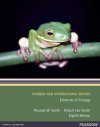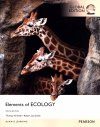About this book
Known for its evolution theme and strong coverage of the relevance of ecology to everyday life and the human impact on ecosystems, the thoroughly revised Eighth Edition features refined quantitative exercises, a restructured chapter on life history, a thoroughly revised species interactions unit including a chapter introducing the subject, and a new chapter on species interactions. To emphasize the dynamic and experimental nature of ecology, each chapter draws upon current research in the various fields of ecology while providing accessible examples that help students understand species natural history, specific ecosystems, the process of science, and ecological patterns at both an evolutionary and demographic scale. To engage students in using and interpreting data, a wide variety of Quantifying Ecology boxes walk through step-by-step examples of equations and statistical techniques. The enhanced companion website (www.ecologyplace.com) features new MapMaster(TM) interactive map activities for exploring ecosystems, physical environments, and populations at regional and global scales, along with popular GRAPHit!, and QUANTIFYit! exercises that help students further master and apply math skills, and a new Pearson eText.
Contents
Glossary
1. The Nature of Ecology
I. THE PHYSICAL ENVIRONMENT
2. Climate
3. The Aquatic Environment
4. The Terrestrial Environment
II. THE ORGANISM AND ITS ENVIRONMENT
5. Ecological Genetics: Adaptation and Natural Selection
6. Plant Adaptations to the Environment
7. Animal Adaptations to the Environment
III. POPULATIONS
8. Properties of Populations
9. Population Growth
10. Life History
11. Intraspecific Population Regulation
12. Metapopulations
IV. SPECIES INTERACTIONS
13. Species Interactions, Population Dynamics and Natural Selection
14. Interspecific Competition
15. Predation
16. Parasitism and Mutualism
V. COMMUNITY ECOLOGY
17. Community Structure
18. Factors Influencing the Structure of Communities
19. Community Dynamics
20. Landscape Ecology
VI. ECOSYSTEM ECOLOGY
21. Ecosystem Energetics
22. Decomposition and Nutrient Cycling
23. Biogeochemical Cycles
VII. BIOGEOGRAPHICAL ECOLOGY
24. Terrestrial Ecosystems
25. Coastal and Wetland Ecosystems
26. Land-Water Margins
27. Large-scale Patterns of Biological Diversity
VIII. HUMAN ECOLOGY
28. Population Growth, Resource Use, and Sustainability
29. Global Climate Change
Customer Reviews
Biography
Thomas M. Smith, Associate Professor in Environmental Sciences at the University of Virginia, received his Ph.D. in ecology from the University of Tennessee in 1982. The main focus of his research over the past two decades has been to develop an individual based theory of community and ecosystems dynamics. As part of this work he has served on numerous national and international panels that have addressed the potential influence of human activities on the global environment. He has authored over 70 publications based on his research, and he has been recognized as one of the most cited scientists in the field of global change research.
Thomas's work has taken him to over 70 countries and 6 continents. He has served on the faculty of the University of Witwatersrand (Johannesburg, South Africa), Australian National University (Canberra, Australia), as well as the University of Virginia (Charlottesville, VA, USA). In addition, he has held research scientist positions at both Oak Ridge National Laboratory (Oak Ridge, TN, USA) and the Institute for Applied Systems Analysis (Laxenburg, Austria). His has over 20 years of experience teaching the science of ecology to both science and non-science majors.
Robert L. Smith holds a Ph.D. in Wildlife Biology from Cornell University. He is Professor Emeritus of Ecology at West Virginia University. He has spent over 30 years teaching Ecology and conducting field research throughout the world.
His teaching responsibilities have involved mostly undergraduate courses in general ecology and graduate courses in population ecology and wildlife management. His research has included forest-fire related problems in southern West Virginia, vegetational development and succession on abandoned and reclaimed surface mines, the relation between forest vegetational structure and the forest bird community, and forest habitat assessment and habitat evaluation procedures based on vegetational structure.
Smith has served as a consultant to congressional committees, workshops on environmental education and energy and environmental problems, the National Landmarks program of the U.S. Department of Interior, National Research Council Task Forces on wildlife and fisheries issues and ecological classification systems for implementing environmental quality evaluation procedures.



























